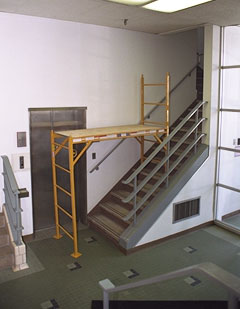Hey all,
As I've been browsing this forum more and more, I keep finding many references to
safety and
OSHA regulations and such. It all got me thinking about how safe our operations are at my high school when we're hanging and focusing
FOH instruments.
We have a bar at
FOH which hangs from the ceiling about 1/3 of the way into the audience. There's no
catwalk or anything, the only way to get up here is from the
ground. Since there are seats below the bar, we are forced to use a ladder that is about 16-20 feet long. But the legs will not fit between the rows of seats. So we have to become creative. We find a large wooden table with legs retracted and set it upside down resting on the seat backs. We mount the ladder on top of the table and viola - you have a wobbly and unsturdy ladder that can slide down the seat backs at will (which are slanted down by the way). Now to actually do anything up there, you obviously have to have instruments and tools. So you grab your 15 pound Source 4 and free climb the ladder. Now you're finally at the top, but to hang the
instrument you need both hands. So you brace your legs against the side of the ladder and lean out to try to get the
safety cable over the bar before you
drop it. During all of this you're basically praying that the table-with-ladder doesn't decide to start sliding down the rows of seats, which if it doesn't make you fall immediately, will give you a nasty bruise or two when that table reaches the front row and there's no more seats. It's worth mentioning that we have no one waiting at the bottom holding the ladder or the table, and nothing even resembling a fall arrest
system. Also, while the aisles are carpeted, the areas under the seats are just cement with nothing over them. But that's only if the hundreds of seat backs below you didn't break your fall (and your neck) first.
I'm kinda curious as to what others think of this. Since we're a high school and we're not paid, I'm pretty sure
OSHA doesn't apply, but assuming it did, would they be mildly uneasy with our setup? Also, does anyone have any ideas about what could be done to make it safer? There's no way we can get anything under there due to the seats, our only possibility would be some sort of a Genie that can extend about 20 feet out to one side. And we can't drive a
cherry picker into our
theatre, so that's not an option either.
Unfortunately, I think it is this way at many other schools. At least 2 other schools in my area have this same situation, and those are just the ones I've seen. I also have seen photos on here and elsewhere of high school theatres with the same issues. Do you all do the same thing, or are you slightly less suicidal than us? I myself have been up on that ladder many times, including once when I came within inches of falling from the top. My right
foot was the only thing that was still on the ladder, and I luckily managed to regain my balance. The next person may not be so lucky.
So... What do ya think?




